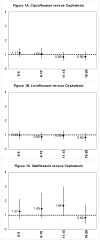Warfarin with fluoroquinolones, sulfonamides, or azole antifungals: interactions and the risk of hospitalization for gastrointestinal bleeding
- PMID: 18685566
- PMCID: PMC2574587
- DOI: 10.1038/clpt.2008.150
Warfarin with fluoroquinolones, sulfonamides, or azole antifungals: interactions and the risk of hospitalization for gastrointestinal bleeding
Abstract
The aim of this study was to determine whether a potential pharmacokinetic interaction between warfarin and orally administered anti-infectives increases the risk of hospitalization for gastrointestinal (GI) bleeding in warfarin users. We conducted a nested case-control and case-crossover study using US Medicaid data. Logistic regression was used to determine the association between GI bleeding and prior use of ciprofloxacin, levofloxacin, gatifloxacin, co-trimoxazole, or fluconazole vs. no exposure and also vs. use of cephalexin, which would not be expected to interact with warfarin. All of the anti-infectives examined were associated with elevated odds ratios (ORs) when compared to no exposure to these drugs. With cephalexin data as the reference, the ORs for co-trimoxazole (OR: 1.68 (95% confidence interval (CI): 1.21-2.33) in the prior 6-10 days) and fluconazole (OR: 2.09 (95% CI: 1.34-3.26) in the prior 11-15 days) were significantly elevated. Warfarin users who had received an anti-infective agent showed a substantially increased risk of GI bleeding. However, a drug-drug interaction with warfarin was evident only for co-trimoxazole and fluconazole.
Figures


References
-
- Bungard TJ, Ghali WA, Teo KK, McAlister FA, Tsuyuki RT. Why do patients with atrial fibrillation not receive warfarin? Arch Intern Med. 2000;160:41–6. - PubMed
-
- Gullov AL, Koefoed BG, Petersen P. Bleeding during warfarin and aspirin therapy in patients with atrial fibrillation: the AFASAK 2 study. Atrial Fibrillation Aspirin and Anticoagulation. Arch Intern Med. 1999;159:1322–8. - PubMed
-
- Breckenridge AM. Interindividual differences in the response to oral anticoagulants. Drugs. 1977;14:367–75. - PubMed
-
- MICROMEDIX. [Accessed: August 10, 2007]. www.thomsonhc.com/hcs/librarian.
-
- Drug Facts & Comparisons 4.0. [Accessed: July 7, 2007]. www.factsandcomparisons.com.
Publication types
MeSH terms
Substances
Grants and funding
LinkOut - more resources
Full Text Sources
Medical

